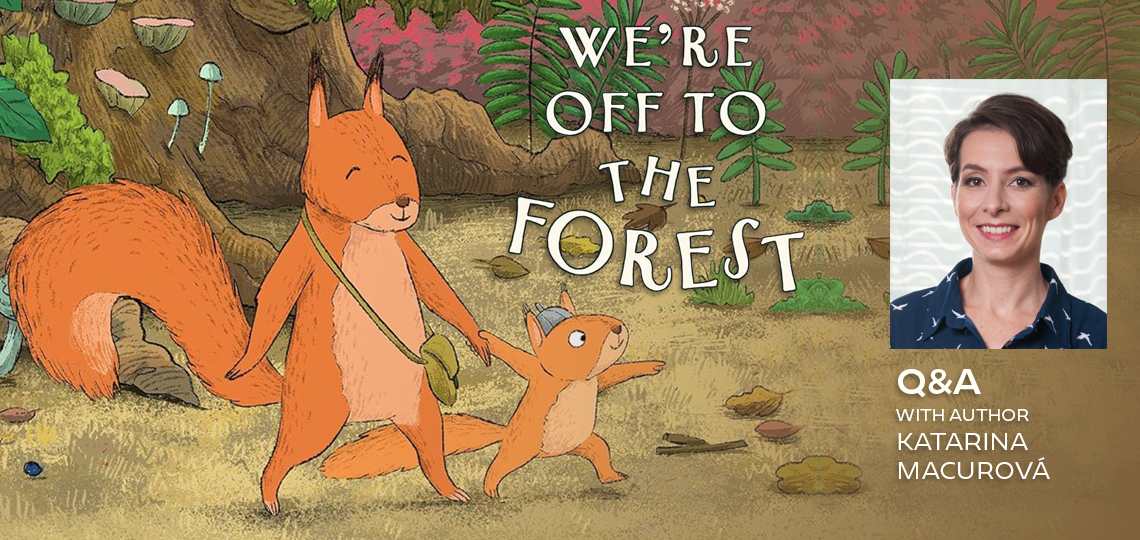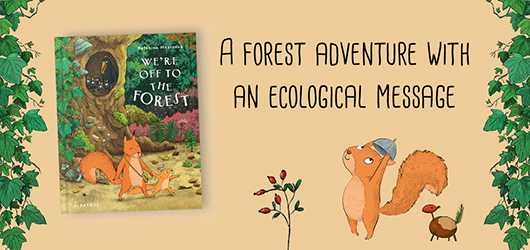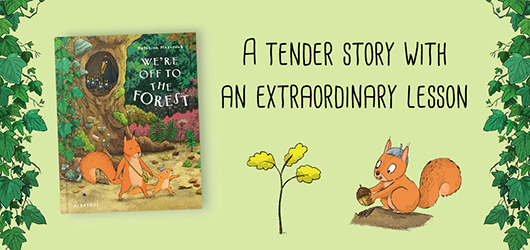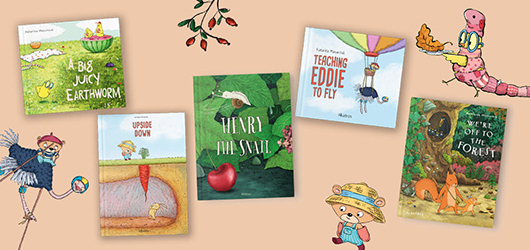We’re Off to the Forest with Katarína Macurová. Will you join us?

Children’s Picture Book Editor Danielle Ballantyne Interviews Katarina Macurova, Author of We’re Off to the Forest
Picture books for children hold a very special place in the hearts of Foreword‘s editorial staff. No other genre offers such a compelling combination of art and story—and the fact that they jump start the love of reading for children across the land is the most gratifying thing we can imagine. So, yes, a great children’s picture book arriving in our offices makes our day.
Over the past couple years, Katarina Macurova has charmed us with beautiful books from her Small Wonders series, and the upcoming release of her latest in the series, We’re Off to the Forest, provided the perfect opportunity to connect Katarina with our Children’s Picture Book Editor Danielle Ballantyne.
This is the fifth book in your Small Wonders series. How has your process and experience changed over the course of the series?
With each book, I feel like I’m gaining more experience, which means I’m also learning more about the process of creating picture books. This has led me to consider more and more details with every new book, which inevitably makes the process more complex. So, in a way, each new title feels more challenging—whether it’s coming up with the story or finding the right visuals. I also try to be mindful that my narration or storytelling approach doesn’t become too repetitive, so I have to stay very focused to avoid falling into familiar patterns. Fortunately, my editor is a great help in this regard, as she’s always able to spot when something in the story either isn’t working or feels too similar to my previous titles.
Where did your inspiration for this cozy autumn tale come from?
We live close to a forest, so we often spend time there. The forest is full of squirrels, and I love watching them chase each other and jump from branch to branch—they’re fascinating creatures. Walks in the forest with my son and husband are incredibly therapeutic for me; I adore the atmosphere, especially in autumn, and I wanted to capture that feeling in the book.
While working on We’re Off to the Forest, I collected various things I found on the forest floor in the fall—pine cones, rose hips, fallen leaves, pieces of bark—and displayed them in my studio. I literally brought the autumn forest atmosphere indoors and surrounded myself with it. Then, I bought colored papers and started matching them with the natural items I had gathered, trying to find color combinations that I liked and that would help create that autumnal mood in the book.
The father and son in your book have a special connection to and appreciation for the forest. Is that a passion that you share?
Absolutely. Several times a year, we retreat to a small cabin in the Slovak mountains to slow down, enjoy nature, and recharge. For me, it’s something I genuinely need as a counterbalance to city life. When I’m walking in the forest, I feel like I can completely switch off, forget about everyday worries, and clear my mind. This, in turn, helps with my creativity. Most of my stories have come to me during these walks, or even while working in the garden.
As both the author and illustrator of We’re Off to the Forest, did you begin working on the book by crafting the words or creating the images? Do you find that one comes more easily to you than the other?
I usually work on the text and illustrations simultaneously, so when I draw something, I’m immediately thinking about the words that might accompany the image. I aim to create a balance where both the text and images equally contribute to moving the story forward. Once I have a draft of the story, I read it over and over to ensure the rhythm of the text works and that every word, comma, and exclamation point has its place. Of course, when I submit the manuscript to the publisher, the text might get some edits, but the essence and atmosphere remain the same.
That said, the visual aspect comes more naturally to me. The image always comes first, and then I think about the text that would fit. I’ve never started with a finished text and then considered the illustrations.
Your illustrations contain so many subtle, whimsical details that it’s possible to read the story ten times and still discover something new. How do you approach creating visuals that are so engaging for both children and their adult helpers?
I always keep in mind that, while the book is meant for a child, it’s usually an adult who reads it to them. If a book is truly engaging, a child will want to read it multiple times. So, I try to include small details in the illustrations that aren’t essential to the plot but can be noticed on repeated readings, giving the sense that there’s always something new to discover. My goal is to entertain or engage not just the child, but also the adult who is reading with them.
Sometimes, I include jokes or elements that have layered meanings—something a child might understand on one level and an adult on another. For example, at the end of the book, the father and son squirrels happily head home, but if you look closely, you’ll see the father has forgotten son’s hat on a tree stump. So when the son says he’s excited to return to the forest someday, the reader knows already it might be sooner than they think :)
What message do you hope children take with them from the book?
I hope children take away the message that everyone can make a difference, even if their actions seem small or insignificant. In the long run, and within a larger context, these actions can have a real impact. Since the book also carries an environmental theme, I wanted to encourage young readers to protect nature, one small step at a time.
Do you have another “wonder” or other project in the works that you could tell us a little about?
At the moment, I’m working on several stories, but I’m not completely satisfied with any of them yet. One is about a little bear named Ernest and is also set in the fall. Another is inspired by the mountain cabin we regularly visit, and the third one is absolutely out of my comfort zone because it features human characters I am not used to drawing, and one of them is a merman. So, we’ll see which of these stories makes it to the finish line!
Danielle Ballantyne



